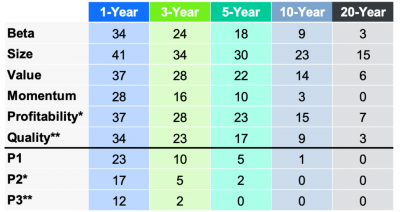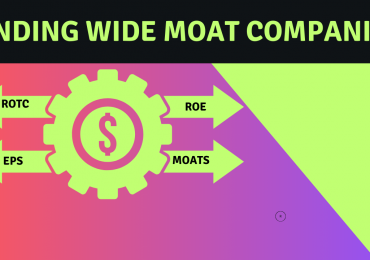By Jack Forehand, CFA, CFP® (@practicalquant) —
I have always been a big believer that factor investing is an effective way to produce returns that beat the market over time. But I also believe that factor investing, especially the focused form of it, is not appropriate for most investors. The reason is that the excess returns that come with factors come with a significant price. That price is the pain that factor investors need to endure during the extended periods where whatever factor they are using isn’t working. I don’t need to remind value investors about that given the decade we just went through. But it applies to all the factors.
Although that pain is the price of admission and can’t be avoided completely, there are some ways to manage it. One of the best ways to do that is to build a portfolio that utilizes multiple factors . Many of us are drawn to a certain factor over the others. For me, that factor is value because buying cheap companies just makes sense to me intuitively. But despite that, I have a very difficult time making a case for only using a single factor in building an investment strategy.
The reason for that is a simple one. If you look at the major factors over time, you will see that all of them have periods where they struggle. You will also see that those periods typically occur at different times and in different types of markets.
To illustrate this, look at this chart that I took from a 2018 article written by Larry Swedroe. It shows the percentage of time that each factor doesn’t work over a variety of time frames. You can see that all the major factors have long periods where they struggle. But if you look at the blends of factors he created (the columns below the dark line) you will see that those underperforming periods are reduced substantially, especially as you move toward the longer time frames.

Blending factors that have strong long-term track records, but also tend to work at different times, effectively results in a free lunch by reducing risk without reducing return.
But the decision to blend factors is the easy part. The hard part is how to do it.
The Two Major Approaches to Multi-Factor Investing
There are two major approaches to building multi-factor portfolios. Different people call them different things, but in general the first method involves treating each factor as a separate portfolio and then combining them together (the sleeve approach), and the second involves using the factors in unison (integration).
Let’s look at a simple example. If I want to build a 20-stock portfolio using only value and momentum, I could do that in one of two ways. Using the sleeve approach, I could select 10 stocks with the highest momentum scores and 10 stocks with the highest value scores. I could then just combine those two portfolios to build my 20-stock portfolio.
Using the integration approach, I would look for stocks with elements of both value and momentum. For example, I might rank all stocks in my database using value and then rank them using momentum and include the stocks with the best combined score in my portfolio. In the real world, integration can be much more complicated than that, but that is the general idea.
So which approach is better?
I don’t know that there is a definitive answer. Whenever there is a debate in investing that has people smarter than me on both sides of it, I tend to settle on the middle ground and just use both.
The Benefits of Integration
But that doesn’t mean each doesn’t have its advantages. The integration method typically maintains higher average scores across the factors because all the factors are considered in the integration process. In other words, you are less likely to have a situation where your value stocks have very low momentum scores and vice versa. Turnover is also likely to be lower. Sheridan Titman, Gregg Fisher and Ronnie Shah discussed this in their 2016 paper “Combining Value and Momentum”.
They explained it the following way:
Our analysis of long-only strategies illustrates how a strategy that simultaneously incorporates both value and momentum outperforms a strategy that combines pure-play value and momentum portfolios that are formed independently. There are two advantages of the simultaneous strategy. The first is the reduction in transaction costs; the second is better utilization of unfavorable value and momentum information in a long-only portfolio
When we interviewed Liqian Ren, who is the Director of Modern Alpha at WisdomTree, for our Five Questions series, she used a simple example of why she prefers integration:
If you want to win a basketball game, you don’t want a team where one person is only great at 3-point shooting, the other only great in dribbling, and the other only great at passing the ball. You want a team with players who stand out at shooting but are also good at dribbling and passing the ball. An individual sleeves approach will invest in stocks that are high value and very low momentum or other factor dimensions.
A Trick Up a Factor Investor’s Sleeve
The sleeve approach also has its advantages. The major one is that it allows a portfolio to retain more pure factor exposures in each sleeve. Whenever you start looking at additional factor exposures, it is likely to at least somewhat reduce your exposure to your original factor. For example, if I am looking for the cheapest stocks using a value strategy, but then decide that I want to require a minimum level of quality, it is likely that the resulting portfolio will have less exposure to value than a portfolio without that constraint. Another advantage is that it can allow an investor to more directly control their factor exposures. For example, if I want a portfolio that is 50% value and 50% momentum, I can just use one sleeve of value stocks and a separate momentum sleeve and make each half of my portfolio.
Jack Vogel of Alpha Architect summed up the benefits of the sleeve approach well in a 2005 article he wrote:
The evidence suggests that we keep highly active exposures to value and momentum in their purest forms (assuming we are doing high-conviction non-watered down versions of the anomalies). Blending the strategy dilutes the benefit of value and momentum portfolios. The summary of the benefits of a pure value and a pure momentum approach can be summarized as follows:
- Easier ex-post assessment
- E.g., if we mix and match value/momentum it is more difficult to identify the drivers of performance after the fact.
- Stronger portfolio diversification benefits.
- Pure value and pure momentum strategies have lower correlations than “blended” versions.
- Stronger expected performance.
- Running pure value and pure momentum in highly active forms generates higher expected performance than blended systems.
A Question Without a Definitive Answer
In the end, I don’t think there is one correct way to build a multi-factor portfolio. Each method has both its pros and cons. Given the strong benefits of using multiple factors, the most important decision is likely the decision to do it in the first place rather than the method that is used.

Jack Forehand is Co-Founder and President at Validea Capital. He is also a partner at Validea.com and co-authored “The Guru Investor: How to Beat the Market Using History’s Best Investment Strategies”. Jack holds the Chartered Financial Analyst designation from the CFA Institute. Follow him on Twitter at @practicalquant.









